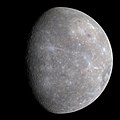集信:Mercury in color - Prockter07-edit1.jpg

集信㭲 (1.950×1.950點影、戟𡱩集信:734kB、矯MIME:image/jpeg)
集信尼得留於威其迷𠫾阿・古門吧伮固体得使用於各預案恪。 𠳒描寫𧵑集信在張模寫得顯示𨑜低。
|
Summary
| DescriptionMercury in color - Prockter07-edit1.jpg |
العربية: صُورة بِألوانٍ مُحسَّنة لِكوكب عُطارد التقطها مسبار مسنجر خِلال عُبُوره الأوَّل بالقُرب من الكوكب المذكور.
Original caption: Color differences on Mercury are subtle, but they reveal important information about the nature of the planet's surface material. A number of bright spots with a bluish tinge are visible in this image. These are relatively recent impact craters. Some of the bright craters have bright streaks (called "rays" by planetary scientists) emanating from them. Bright features such as these are caused by the presence of freshly crushed rock material that was excavated and deposited during the highly energetic collision of a meteoroid with Mercury to form an impact crater. The large circular light-colored area in the upper right of the image is the interior of the Caloris basin. Mariner 10 viewed only the eastern (right) portion of this enormous impact basin, under lighting conditions that emphasized shadows and elevation differences rather than brightness and color differences. MESSENGER has revealed that Caloris is filled with smooth plains that are brighter than the surrounding terrain, hinting at a compositional contrast between these geologic units. The interior of Caloris also harbors several unusual dark-rimmed craters, which are visible in this image. The MESSENGER science team is working with the 11-color images in order to gain a better understanding of what minerals are present in these rocks of Mercury's crust. The diameter of Mercury is about 4880 kilometers (3030 miles). The image spatial resolution is about 2.5 kilometers per pixel (1.6 miles/pixel). The WAC departure mosaic sequence was executed by the spacecraft from approximately 19:45 to 19:56 UTC on January 14, 2008, when the spacecraft was moving from a distance of roughly 12,800 to 16,700 km (7954 to 10377 miles) from the surface of Mercury. |
||||||
| Date | |||||||
| Source |
NASA. |
||||||
| Author | National Aeronautics and Space Administration/Johns Hopkins University Applied Physics Laboratory/Carnegie Institution of Washington | ||||||
| Other versions |
|
Licensing
| Public domainPublic domainfalsefalse |
| This file is in the public domain in the United States because it was solely created by NASA. NASA copyright policy states that "NASA material is not protected by copyright unless noted". (See Template:PD-USGov, NASA copyright policy page or JPL Image Use Policy.) |  | |
 |
Warnings:
|
Original upload log
This image is a derivative work of the following images:
- Image:Mercury_in_color_-_Prockter07.jpg licensed with PD-USGov-NASA, PD-USGov-NASA/copyright
- 2008-02-18T06:16:52Z Superm401 3000x2025 (1325745 Bytes) Reverted to version as of 01:42, 31 January 2008
- 2008-01-31T01:52:50Z Kwamikagami 2072x2025 (1091977 Bytes)
- 2008-01-31T01:42:24Z Kwamikagami 3000x2025 (1325745 Bytes) {{Information |Description=Full color image of Mercury from first MESSENGER flyby |Source=NASA/APL |Date=2008 Jan 30 |Author=NASA |Permission=public |other_versions=color version of [[Image:MESSENGER first photo of unseen sid
Uploaded with derivativeFX
Captions
copyright status English
public domain English
inception English
30 January 2008
media type English
image/jpeg
歷史集信
扨𠓨𣈜/𣇞抵䀡內容集信在時點妬。
| 𣈜/𣇞 | 形䀡𠓀 | 戟櫸 | 成員 | 描寫 | |
|---|---|---|---|---|---|
| 現在 | 22:12、𣈜3𣎃6𢆥2008 |  | 1.950×1.950 (734kB) | wikimediacommons>Jjron | {{Information |Description={{Information |Description=Full color image of from first MESSENGER flyby |Source=NASA/JPL [http://messenger.jhuapl.edu/gallery/sciencePhotos/image.php?page=1&gallery_id=2&image_id=143] |Date=2008-01-30 |Author=NASA/[ |
張使用集信
張𢖖󠄁使用集信尼:
特性形
集信尼貯通信補充、固体得添自𣛠影技術數或𣛠𢭯得使用抵造或數化集信。
裊集信㐌得𢯢𢷮𬧺貝狀態班頭、𠬠數枝節固体空反暎𣹓𨁥集信㐌𢯢𢷮。
| 向 | 常 |
|---|---|
| 分解蹺朝卬 | 300點/印初 |
| 分解蹺朝高 | 300點/印初 |
| 份繌使用 | Adobe Photoshop CS Windows |
| 𣈜𣇞𢯢集信 | 00:58、𣈜4𣎃6𢆥2008 |
| 空間𦭷 | sRGB |

